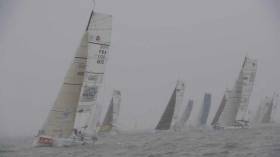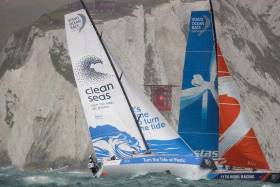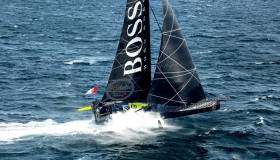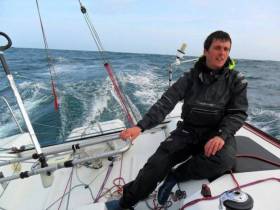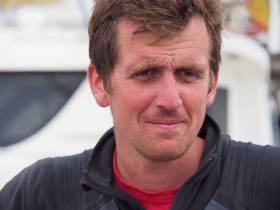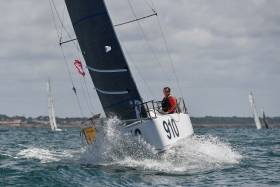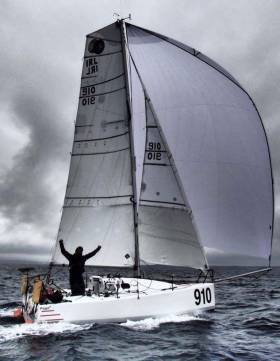Displaying items by tag: Tom Dolan
The weather played a sly hand on Sunday morning in the Bassin des Chalutiers and it has not been kind to Ireland's solo sailor Tom Dolan who is at the back of the pack aftter the first 14 hours of the 2017 Mini–Transat.
The persistent drizzle and low cloud did little to cheer those Mini sailors feeling the pressure as they cast off. Ultimately though, there was a sense of relief all round that they were finally getting going with their race, a moment they've been working towards for the past two years. After a lively start for the first few hours, it promises to be a fine crossing.
For all that, the first few miles of this Mini-Transat La Boulangère will be far from restful. With upwind conditions and rough seas with a substantial south-westerly swell, the solo sailors' stomachs are likely to be finding things tough this evening.
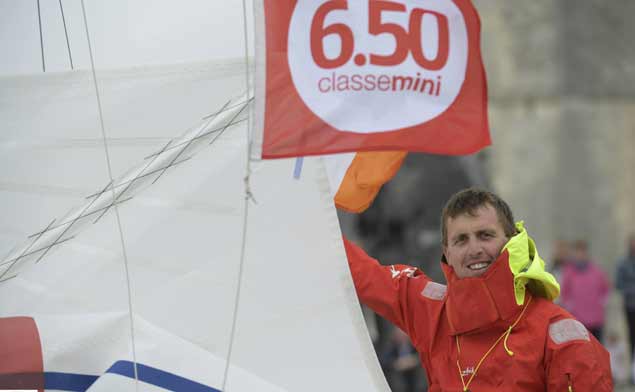 County Meath sailor Tom Dolan Photo: Oliver Blanchet/Facebook
County Meath sailor Tom Dolan Photo: Oliver Blanchet/Facebook
Current predictions suggest that the upwind conditions should be succeeded by some boisterous downwind sailing as the fleet close on Cape Finisterre, according to Christian Dumard, the weather guru from Great Circle. Essentially, to the south of this headland, the Mini sailors can expect stronger winds in a corridor spanning around a hundred miles offshore of the coast of Galicia and Portugal. As such, the competitors will have to choose between distancing themselves from this corridor, by gaining headway to the west and potentially having to cover extra miles away from the direct route, or hunkering down in a bid to escape the worst of the wind up ahead. However, the solo sailors aren't there yet. Between now and the north-west tip of Spain, things could play out in a number of ways.
It was in a persistent drizzle that the fleet took today's start in a W to SW'ly wind of 10 to 15 knots. Almost perfect conditions then, save for the zero visibility in the squalls.
Three competitors are unfortunately having to make a stopover in La Rochelle to effect repairs. The first to announce his return was Fred Guerin (Les-amis.fun), whose hull was holed in a collision with Elodie Pedron (Manu Poki & les Biotecks), she too retracing her steps. Finally, Gwendal Pibot (Rossinante) announced that he would also be returning to the Port des Minimes after breaking his stay.
Race tracker here
Dolan Aims for Podium in Mini Transat, Irish Sailors Gather in France to Salute Solo Bid
Irish Sailing President Jack Roy was on hand in Bassin des Chalutiers, La Rochelle today to wish sole Irish entry Tom Dolan good luck in tomorrow's Mini Transat Race start.
An eve of race Irish reception with the Cultural & Sporting Attache from the Irish Embassy was held in the National Yacht Club sailor's honour. Roy was among a number of Irish sailors in France to wish the intrepid County Meath sailor the very best for his Transatlantic Race ambitions.
Dolan's aim is a podium place, and he has been on that podium or near it in almost every race this past summer. But now it’s down to the moment of truth tomorrow, to race the 1,350 miles to Gran Canaria, about a week of sailing following which there’s a pause while they wait for the current very vigorous hurricane season to end, and then they race the 2,700 miles Transatlantic miles to Le Marin in Martinique.
Read Afloat's Mini Transat Race preview with a special focus on Tom Dolan by W M Nixon here.
Annalise Interest Shows That International Sailing Programme Has New Ordering of Priorities
In the days when sailing was a seasonal sport, a few main pillar events dominated the international programme. The Sailing Olympics. The America’s Cup. The Fastnet Race. The Dragon Gold Cup. The Sydney-Hobart Race. The Whitbread Round the World Race. And maybe a few others – we all had our favourites writes W M Nixon.
There weren’t many of those key events. Yet in a more leisurely era of primitive communication, they were enough to be going along with, and people became accustomed to the long intervals between them, intervals when we could concentrate obsessively on our own local and national sailing at events which were of little interest to anyone else.
But the advent of the Internet has changed sailing as it has changed everything else. Instant 24/7 communication demands a fast-running stream of narrative with images to match. In this new environment, the former pillar events find they are just part of an endless tapestry, and they have to take their chances with everything else to gain attention.
Time was when the fundamental changing of boat types in the America’s Cup would have been a matter of major interest, blowing every other sailing headline off page and screen in a big way, and for a long time.
But we’ve comfortably taken in our stride the recent gradually-released information that sailing’s peak event - the oldest international sporting challenge in the world - is reverting to mono-hulls, after three editions of supposedly setting the world a-fire with hyper-fast catamarans.
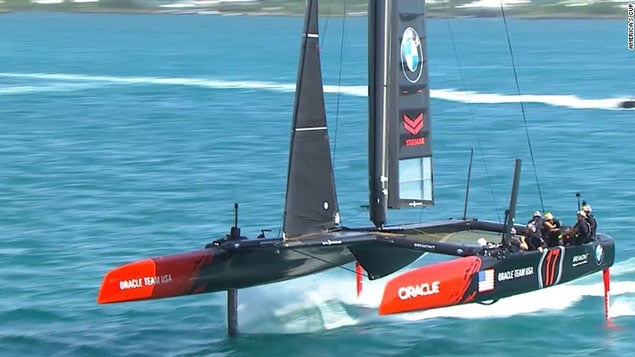 So, farewell then, catamarans in the America’s Cup……Oracle unsuccessfully defended against Emirates New Zealand in Bermuda in June.
So, farewell then, catamarans in the America’s Cup……Oracle unsuccessfully defended against Emirates New Zealand in Bermuda in June.
Here and there, devoted pot-stirrers found it difficult to provoke anyone to break sweat over the matter. Maybe in the core of the America’s Cup community – if there is such a thing – there was a weeping and wailing and gnashing of teeth. But among the rest of us, there was sublime indifference. We knew there’d be time enough to consider the new boats as the outlines of the next challenge became more clearly defined. And if there’s litigation in the meantime, that will be entertainment. Meanwhile, there’s a busy Autumn programme of major international events, several of which have a significant Irish interest, and that’s where our attention is focused.
Currently, the top story still has to be the confirmation of Annalise Murphy as a crewmember aboard the Volvo Ocean Racer Turn The Tide On Plastic. The sense of excitement when she was mentioned as a “probable” was tempered by the fact that she’d sustained that knee injury during a crazy capsize in the last race on her way to becoming the International Moth Women’s World Champion, and we’d to wait for total recovery from it before the Volvo World Race chapter in her life could properly begin.
 Game for anything. Annalise Murphy giving her all on the foiling Moth, in which she is now Women’s World Champion.
Game for anything. Annalise Murphy giving her all on the foiling Moth, in which she is now Women’s World Champion.
Quite what her sports physio Mark McCabe had to say about the injury is probably unprintable, for a point made about her campaign towards the Olympic Silver Medal was that it was his guidance and skill which kept her injury-free at crucial stages in training and during the Olympic campaign.
We should all have a Mark McCabe for everyday life. But for now, the Olympics seem so yesterday in the Annalise story, for what she has undertaken may be sailing, but it certainly isn’t sailing as she has known it for so many years with a Laser Radial.
But despite that capsize, clearly she could hack it with the special demands of a foiling Moth, so now she is now re-shaping her enthusiasm, basic athleticism and special sailing skills to serve a team cause. And as of this morning, it has to be the most interesting single story in Irish sailing, particularly now that the Volvo 65s and their teams are gathered in Alicante, with the entire fleet being lifted out on Monday for the final meticulous checks.
There’s a special edge to it, for this year’s race - which starts on October 22nd - will see a much greater emphasis on the Southern Ocean. So as we move steadily towards the Centenary in 2023 of the beginning of Conor O’Brien’s pioneering of the global southern route for yachts with his Irish-built 42ft Saoirse, it’s more than appropriate that there’s a significant Irish presence in the developing Volvo setup, where the Alicante Volvo Race Village will open on 11th October, and the In-Port Race will be staged on Saturday October 14th.
 Conor O’Brien, pioneer for yachts in the Southern Ocean on the Cape Horn route.
Conor O’Brien, pioneer for yachts in the Southern Ocean on the Cape Horn route.
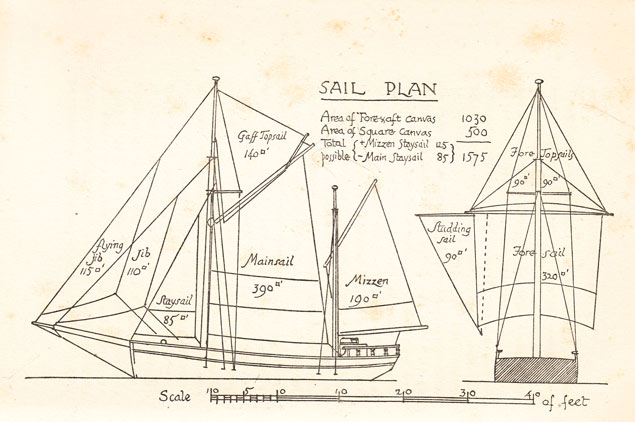 A very different sort of boat from today’s Volvo 65. The traditonal-style 42ft gaff ketch Saoirse, built in Baltimore in 1922, proved remarkably successful at running fast yet safely in the Southern Ocean. Conor O’Brien designed a rig that relied on a squaresail on the mainmast, setting a triangular studding sail and topsail
A very different sort of boat from today’s Volvo 65. The traditonal-style 42ft gaff ketch Saoirse, built in Baltimore in 1922, proved remarkably successful at running fast yet safely in the Southern Ocean. Conor O’Brien designed a rig that relied on a squaresail on the mainmast, setting a triangular studding sail and topsail
King of it all for Ireland has to be Damian Foxall, who has raced or broken records round the world so often he has probably lost count, but this time he’s on the strength of Team Vestas. For Foxall, the link to Conor O’Brien is particularly special, as Damian hails from Derrynane in far southwest Kerry, and Derrynane was Conor O’Brien’s favourite port – you can see his signature in the Visitors’ Book in that superb watering hole so beloved of voyagers, Bridie Keating’s pub.
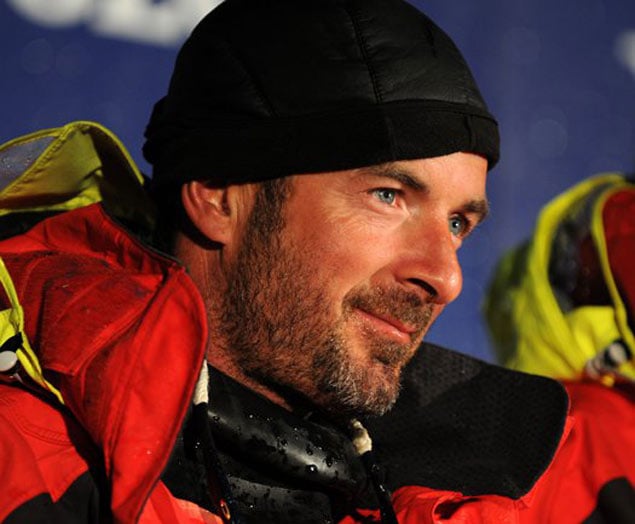 Damian Foxall in virtually unrivalled in his Volvo Ocean Race experience
Damian Foxall in virtually unrivalled in his Volvo Ocean Race experience
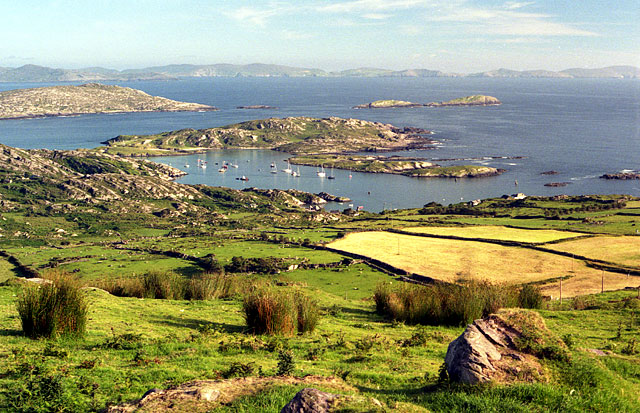 Derrynane in Kerry – Conor O’Brien’s favourite anchorage, and Damian Foxall’s home port
Derrynane in Kerry – Conor O’Brien’s favourite anchorage, and Damian Foxall’s home port
But if Damian is King, Annalise is Queen, for even among the hugely talented Volvo crews, an Olympic Silver Medal – or any Olympic Medal for that matter - is rare enough. Indeed, it’s so rare that part of the fascination of the Annalise/Turn the Tide on Plastic linkup will be in how they work out together.
Annalise carries the flag for Ireland’s east coast in Alicante, while Justin Slattery will do it for the south if he turns up, as Damian Foxall expects. Others from Ireland include James O’Mahoney who’s also with Team Vestas, where Thomas John McMaw is Senior Project Manager to keep up the green jersey count, as too does VOR event contractor John Donnelly.
But as our colleague Tom MacSweeney pointed out on Afloat.ie on Monday, it is Kerry which packs the punch in Alicante, as Brian Carlin of Tralee leads the team of OBRs (On-Board Reporters) who will be embedded on each boat, while Lucy Hunt who runs the Sea Synergy Awareness Centre at Waterville (it’s just over the mountain pass from Derrynane) is Sustainability Education Manager for this edition of the Volvo Ocean Race, and will co-ordinate a schools programme.
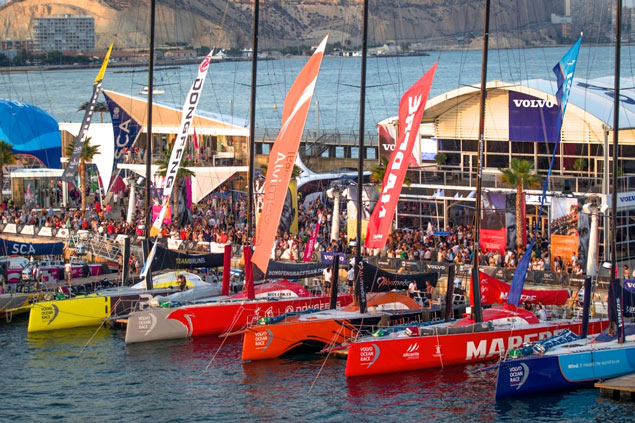 A long way from Derrynane….the Volvo Village at Alicante
A long way from Derrynane….the Volvo Village at Alicante
However, for those who like to be up to speed with all in the main international sailing stories with Irish interest, some time soon there’ll be the Student Yachting Worlds in Marseilles, where UCD led by Will Byrne will be challenging for a trophy which Ireland has won in times past. Originally we were told it would be in September, but when students are running the show themselves, there’s freeform organization and timing, and the most recent date we see is still Marseilles, but not until October 17th to 22nd.
So the top up-coming interest is in La Rochelle towards the end of September, with the fleet gathered for the two-stage 4050 mile Mini-Transat (there’s a stop in the Canaries), with the race starting on Sunday October 1st. Ireland’s Tom Dolan with IRL 910 is currently fourth in the world rankings in the Mini Transat Production Boat Class, so he’s in with a good shout for a podium place. And we’re all behind him, with Irish Sailing President Jack Roy and Ireland’s Sports and Cultural Attaché in France the Guests of Honour at Tom’s party in La Rochelle at noon on Saturday September 30th.
 Ireland’s Tom Dolan, currently fourth in the world rankings. His supporters will be gathering in La Rochelle in the week leading up to Sunday October 1st to wish him well when he starts the Mini-Transat, with the main party on Saturday September 30th.
Ireland’s Tom Dolan, currently fourth in the world rankings. His supporters will be gathering in La Rochelle in the week leading up to Sunday October 1st to wish him well when he starts the Mini-Transat, with the main party on Saturday September 30th.
Then in October, in addition to the Volvo World Race start and the Student Yachting Worlds, there’s the Rolex Middle Sea Race from Malta on Saturday October 21st, just the day before the Volvo gets going across in Spain. But there’s always lots of Irish interest in this annual Mediterranean classic, with the winning Cookson 50 Mascalzone Latino last year being navigated by our own Ian Moore, while this year there’s added spice with the possible inclusion of the IMOCA 60 Hugo Boss with Alex Thomson and Nin O’Leary hoping they’ll find conditions better suited to their very specialised flying machine than they did in the Fastnet Race back in August.
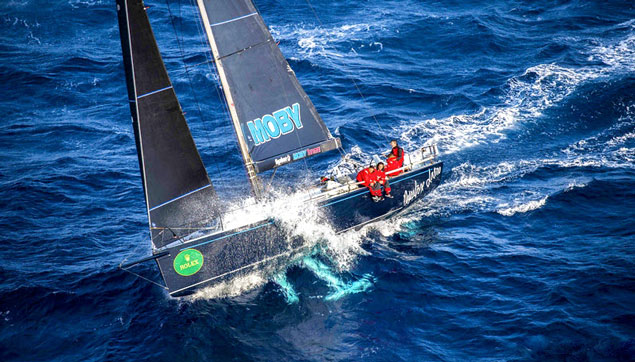 The Cookson 50 Mascalzone Latino being navigated by Ian Moore to overall victory in the Rolex Middle Sea Race 2016. Photo Rolex
The Cookson 50 Mascalzone Latino being navigated by Ian Moore to overall victory in the Rolex Middle Sea Race 2016. Photo Rolex
For those who look on into November, the Transat Jacques Vabre gets going from Le Havre on November 5th with a preponderance of IMOCA 60s, but for operational reasons Hugo Boss is not expected be among them. However, what’s clear is that the international programme is now non-stop, for by November we’ll be getting advance info on the Sydney-Hobart Race on 26th December 2017, which is the saving of Christmas for many of us.
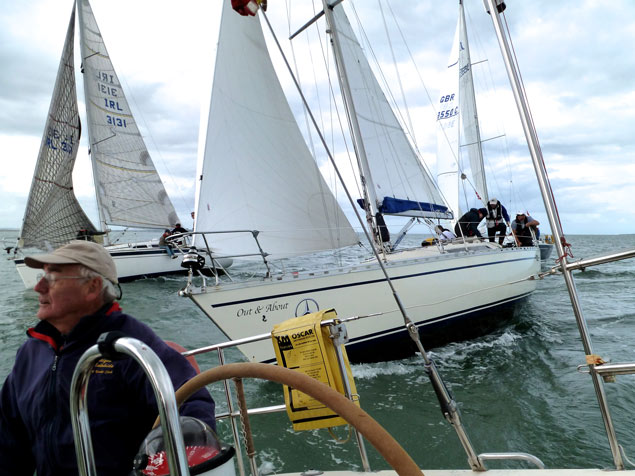 When cruisers battle for it - racing the Autumn League at Howth. Photo: W M Nixon
When cruisers battle for it - racing the Autumn League at Howth. Photo: W M Nixon
Meanwhile this morning in Douarnenez in Brittany the Figaro Fastnet Solo gets under way, and Autumn Leagues start to flex their muscles in Ireland, with Howth’s series starting today and running for six weekends, so the topline action continues at home and abroad in an unending stream.
There’s an old Arab saying which goes: “The dogs bark, but the caravan moves on”. It could reasonably be said of world sailing that there may indeed be dogs barking, but the purposeful rattling of camel harnesses is now virtually continuous.
How Much in the Sponsorship Pot for all These Irish Offshore Sailing Superstar Hopefuls?
There have been several Irish offshore racing sailors who have been making national and world headlines for some years now, but in recent weeks and months the wave of new enthusiasm for the big ticket events has surged to fresh heights.
One of the stories underlying all this is the potential for a specialist marine industry base in Cork Harbour serving the continuous needs of the most advanced racing machines, and providing a launch pad for global campaigns. The idea has been around for some time now, but as reported in Afloat.ie as long ago as April 1st 2015, while the goodwill may be there, a firm decision is still awaited.
Local minister Simon Coveney has since moved on from the Marine to other Government departments. His present very senior role in representing Ireland through the Department of Foreign Affairs in decidedly turbulent times will mean that the needs of something so difficult to gauge for significant political and economic benefits will scarcely be top priority.
Yet for the many leading Irish sailors – both men and women – who have launched themselves into the decidedly uncertain world of top level professional competition, the problem of resources and facilities to keep the show on the road is always present, and frequently at crisis levels. W M Nixon wonders how there is going to be enough in the sponsorship pot – both nationally and globally – to help them all fulfill their dreams.
On Tuesday, Afloat.ie received confirmation of a “virtual press conference” in Cork, in other words a clearcut announcement that Nin O’Leary’s co-skippering of the IMOCA 60 Hugo Boss with Alex Thompson was going to move on to a full-blooded Vendee Globe campaign by O’Leary himself, possibly with a new boat.
 The then Minister for the Marine Simon Coveney, Hugo Boss skipper Alex Thomson, and Stewart Hosford at the announcement in Cork in 2015 of a possible international offshore racing hub on Haulbowline Island.
The then Minister for the Marine Simon Coveney, Hugo Boss skipper Alex Thomson, and Stewart Hosford at the announcement in Cork in 2015 of a possible international offshore racing hub on Haulbowline Island.
In the meantime, the word on the waterfront is that the two skippers may do the two-handed Barcelona World Race 2018 in the current boat. But beyond that, the campaign plan for the charismatic O’Leary, mentored by Thomson and orchestrated by Stewart Hosford, is rumoured to be the building up of enough resources to keep this boat, yet also build a new one.
This is because the boat is still almost state-of-the-art, she has some features still absent in other boats, and could be serious opposition in someone else’s hands. Thus the ideal scenario is to maintain control of their current technology and design, while moving on to the next stage of development with an even more advanced boat for the Vendee Globe in 2020.
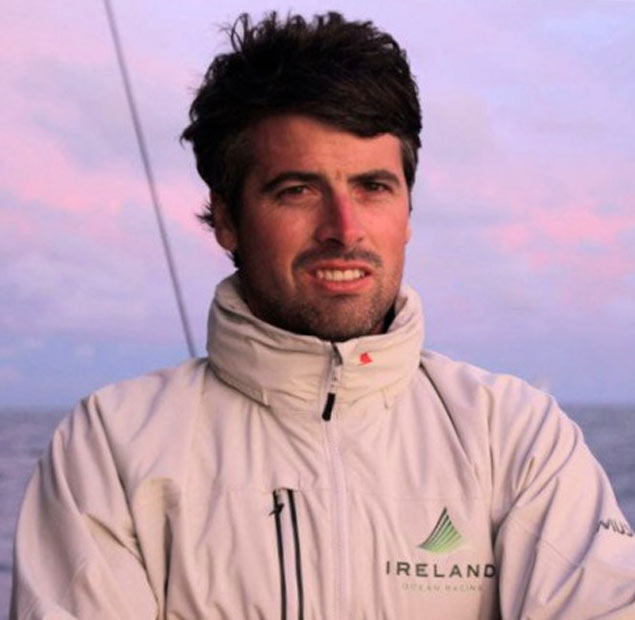 Nin O’Leary – a charismatic figure for Ireland’s younger sailors
Nin O’Leary – a charismatic figure for Ireland’s younger sailors
We’re talking mega-bucks here, and the relationship with Hugo Boss has been very fruitful, but the elephant in the room - which hasn’t been mentioned yet - is how long will the Hugo Boss sponsorship continue?
This may all become clearer within the next ten days, as Thomson, O’Leary and Hugo Boss are headed for Ireland, with Cork in their sights on Monday 28th and Tuesday 29th August, and then they’re in Dun Laoghaire for a very public appearance on Wednesday August 30th, and staying until the Friday, September 1st for the ongoing launch of their new brand Ireland Ocean Racing.
This puts them top of the billboards. But we mustn’t let it blind us to the hopes of other campaigners, and on Thursday of this week, Tom Dolan made his final public appearance in Ireland before returning to France for the countdown towards the start of the Mini Transat 2017 from La Rochelle at the beginning of October.
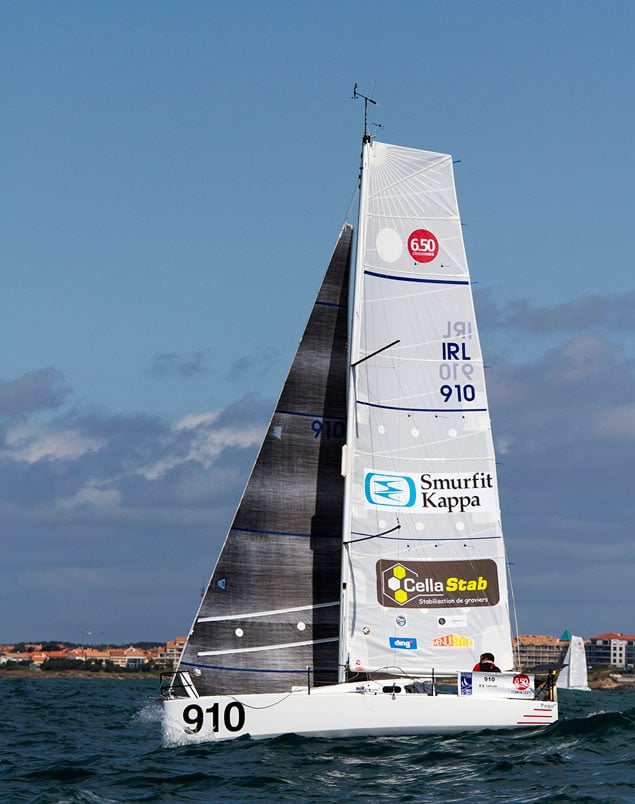 Although Tom Dolan has some sponsorship for IRL 910, there is still a shortfall in funding for the Mini Transat 2017 which starts at the beginning of October from La Rochelle
Although Tom Dolan has some sponsorship for IRL 910, there is still a shortfall in funding for the Mini Transat 2017 which starts at the beginning of October from La Rochelle
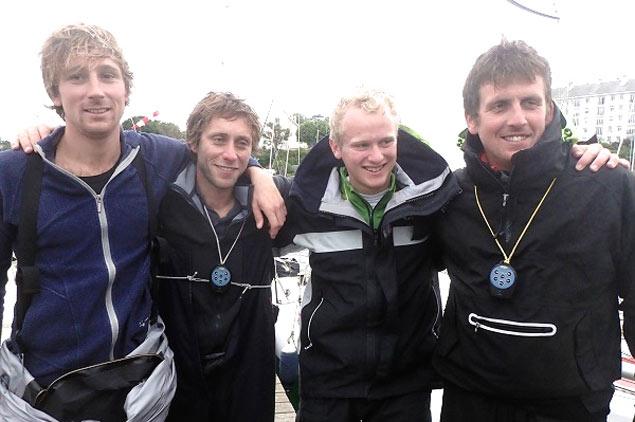 Tom Dolan (right) and fellow skippers in the Mini 650 class at Concarneau. The camaraderie and mutual help among the sailors contributes to France’s dominant position in short-handed sailing
Tom Dolan (right) and fellow skippers in the Mini 650 class at Concarneau. The camaraderie and mutual help among the sailors contributes to France’s dominant position in short-handed sailing
Although Tom has some support backers whose logos appear on his sails, he makes no bones about his overall situation, as his Pogo 3, IRL 910, currently enters races under the name of “Still Seeking a Sponsor”. Whether his presentation in the National YC on Thursday will turn on any money taps in Ireland remains to be seen, the fact is that it’s in France he makes most impact. But in Dun Laoghaire, his burning enthusiasm left an abiding impression, for although his chosen life-path may be more exciting than running the small family farm in Meath, there are times when it’s a massive struggle.
Tom is one of several Irish international offshore wannabees and established skippers who have made a point of having the cup of coffee with Marcus Hutchinson. Hutchinson has transformed himself from being a young sailor who first learned his craft in Howth into an international sailing campaign management figure who maintains his Irish connections through Kinsale, yet is now a key presence at the French-led cutting edge of specialist offshore programmes.
 Marcus Hutchinson is first Port of Call for anyone seriously contemplating a short-handed offshore campaign
Marcus Hutchinson is first Port of Call for anyone seriously contemplating a short-handed offshore campaign
It’s rumoured that in Brittany he has access to a large warehouse full of IMOCA 60s and Open 40s and whatnot. What we do know for sure is that he was very much the background force in Paul Meilhat’s stunning victory in the IMOCA 60 SMA in the recent Rolex Fastnet Race, a neatly-read campaign whose success was highlighted by the inescapable fact that Hugo Boss finished eighth out of the nine IMOCA 60s competing.
SMA with her dagger boards was optimized for windward work, whereas Hugo Boss with her foils most emphatically wasn’t. But while those in the know are aware of this, Joe Public simply sees the final results and takes it from there.
 The Marcus Hutchinson-managed SMA was convincing winner of the IMOCA 60 Class in the Rolex Fastnet Race 2017. Photo: Carlo Borlenghi
The Marcus Hutchinson-managed SMA was convincing winner of the IMOCA 60 Class in the Rolex Fastnet Race 2017. Photo: Carlo Borlenghi
Marcus Hutchinson’s deep well of sound advice is available to those who seek him out, and he is generous with his knowledge and sensible thoughts. Talking to Afloat.ie yesterday morning, he made the point that of the current wave of French superstars in the bigger boats, many have done the Figaro Solo at least a dozen times, and he reckons that setting out to take on the Vendee Globe straight from a career – however successful – in fully-crewed boats, is akin to taking on Everest solo without first trying a few smaller mountains on your own.
The list of those specialist sailors from Ireland who have made a point of seeking advice and assistance at some stage from Marcus Hutchinson is both impressive and fascinating, as it includes Damian Foxall, Justin Slattery, Enda O'Coineen, David Kenefick, Joan Mulloy, Sean McCarter, Tom Dolan and most recently Conor Fogerty.
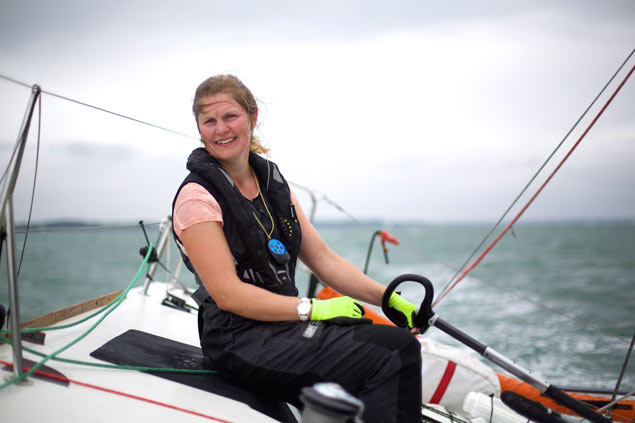 Joan Mulloy of Westport in County Mayo has secured a Figaro through Marcus Hutchinson, but still requires sponsorship
Joan Mulloy of Westport in County Mayo has secured a Figaro through Marcus Hutchinson, but still requires sponsorship
 David Kenefick of Cork is another solo sailor who was guided into the Figaro Class by Marcus Hutchinson
David Kenefick of Cork is another solo sailor who was guided into the Figaro Class by Marcus Hutchinson
And a salient fact which emerges in talking to some of them is the thought that while the Alex Thomson/Hugo Boss campaign was impressive, its central ethos of being stand-alone was ultimately counter-productive.
Two of the lone skippers mentioned above went so far as to say that if the Hugo Boss campaign had been prepared to mix it a bit more with the strongholds of French single-handed sailing in Brittany, then they would have won the Vendee Globe instead of coming second.
That’s undoutedly one for the speculation mill. But it gets a certain reinforcement from a statement this week from Nin O’Leary, to the effect that moving the base from Portsmouth to Cork would have the beneficial result of making the major French centres seem more accessible, as there’s almost a feeling of being trapped in the Eastern Solent, whereas in Cork it’s open water – and open thinking - all the way to Ushant and beyond.
This desire for open water and open thinking is spreading. One of the most interesting news items of recent weeks was that Olympic Silver Medallist Annalise Murphy hoped to secure a berth aboard Dee Caffari’s Volvo 65 for the up-coming Volvo World Race. Unfortunately the knee injury Murphy exacerbated with a spectacular capsize at the conclusion of becoming the International Moth Women’s World Champion 2017 on Lake Garda has put that idea on hold, but this shift of interest from the grind of Olympic training on a tedious four year cycle to the more stimulating world of big-time offshore stuff, with maior events coming up in rapid succession, reflects a discernible pattern of changing public awareness.
 The new Volvo 65 Turn the Tide on Plastic. Olympic Silver Medallist Annalise Murphy had to defer taking up a berth on Dee Caffari’s Volvo 65 because of a knee injury sustained during a capsize in the Moth Worlds at Lake Garda
The new Volvo 65 Turn the Tide on Plastic. Olympic Silver Medallist Annalise Murphy had to defer taking up a berth on Dee Caffari’s Volvo 65 because of a knee injury sustained during a capsize in the Moth Worlds at Lake Garda
So Olympic sailing, ever mindful of the need to continue to attract public attention by whatever means, is going to include a test offshore series, probably for two person boats, in the Tokyo Olympics in 2020.
This is of particular interest to any Irish sailor desperately seeking sponsorship, for the reality is that on our island, there are only half a dozen sports – if that - which are big enough to make an impact on their own. The minority sports - sailing included - only figure significantly in public awareness if they come up in the Olympic searchlight.
That Olympic searchlight in turn encourages others to get involved, thereby stretching the cloak of sponsorship ever thinner. So it will be some time, if ever, before we see a joint approach to the challenge of raising sponsorship for this branch of sailing. And Heaven knows, but it’s difficult enough to get an effective short-handed sailing campaign of international standard up to speed without the endless worry of finding the money. Yet that’s the way it is. But if you really do find the challenge irresistible, Afloat.ie’s advice is to make arrangements to have a cup of coffee with Marcus Hutchinson before you do anything else.
Tom Dolan Has to Be Content With Fourth in Trangascogne 2017
The arrival earlier than expected of a fresh nor’wester in the Bay of Biscay in the final approaches to Les Sables d’Olonne at the finish of Stage 2 of Transgascogne 2017 last night put paid to Ireland’s Tom Dolan’s chances of a podium position for IRL 910 in the Mini 650 Class writes W M Nixon.
During the day yesterday, Dolan had taken full advantage of the veering northeast to east wind, which became fresher in his part of the course. At one stage, he had his boat Still Seeking a Sponsor leading the northern group by more than six miles. If these wind conditions had persisted as long as expected, he could have placed himself into an unassailable position between the northern group and the finish line by the time the nor’westerlies spread in.
But it was not be. Far out on the northern wing, Erwan le Draoulec and Clarisse Cremer - after being virtually becalmed for a while – found themselves being swept along for the final 20 miles at speeds of 8 knots plus. As for Tom Dolan, in a position which was now to lee, it was all he could do to get above six knots while still laying the finish line, and his problem became that of staying in third place ahead of Germain Kerlevo, who was approaching the finish to the north of him, coming rapidly in from astern along the Rhumb Line.
At the finish, Le Draoulec was twenty minutes ahead of Clarisse Cremer, which means she still wins the Trasngascogne 2017 on aggregate, as her sensational breakaway win of an hour ahead of le Draoulec at Aviles gives her a very comfortable time cushion. However, le Draoulec is firmly in second overall as his one hour margin over third-placed-at-Aviles Germain Kerlevo made his second overall very soundly based.
But with conditions in the new nor’wester now dominating the final miles, Kerlevo swept through to finish fourth twenty minutes ahead of Dolan, placing the Irishman fourth overall in the 53-strong fleet. Tom Dolan is still seen very popularly as “The Flying Irishman” and very much a boat to beat in the tight-knight Mini 650 community. But a podium place at this part of the campaign towards the Mini-Transat start at the beginning of October would have been a useful bonus at this stage of the programme.
Tracker here
Another Agonising Finish in Sight for Tom Dolan
With just 19 miles to the finish in Les Sables d’Olonne tonight, Ireland’s solo sailor Tom Dolan is currently leading the Mini 650 Class in Stage 2 of the Transgascogne 2017 from Aviles in northwest Spain writes W M Nixon. But his position is being rapidly eroded by a new nor’west breeze which has spread in to favour Erwan le Draoulec and Clarissa Cremer, who are well to the north of the rhumb line.
By the time harbour is reached, it is likely that Dolan’s biggest challenge will be to keep himself in third place, and thus finish third overall with a podium place when the times for the two legs are totalled. Cremer is carrying an advantage of two hours, and Le Draoulac of one hour, as a result of the extremely flukey finish of the outward leg, when Dolan missed third place by just one second.
All three leading boats are laying the line, but Cremer and Le Draoulec are sailing freer and faster, and everything points to them being in the lead at the finish. Thus unless there’s a total reversal of fortune, Dolan’s main objective is rapidly becoming that of staying ahead of Pierre Chedeville (currently 1.5 miles directly astern of him), and Germain Kerlevo, who holds a windward berth but is recorded as three miles further from the finish.
Tracker here
Ireland’s Mini Transat entrant Tom Dolan has had to make some tough tactical decision in the 245-mile Stage 2 from Aviles in Spain back to les Sables d’Olonne in the Mini Transgascone 2017 writes W M Nixon. Although an anticipated veering in the northeast wind has been developing, it has been taking place later than forecast. But Dolan’s decision to hold well to the right – in which he was followed by close rival Pierre Chedeville – is now being rewarded, though for some time he has relinquished his early lead to Erwan le Daroalec, who with Clarrisse Cremer had elected to hold well to the left.
In terms of the usual pattern of Mini 650 racing, the four front runners are exceptially widely spread across a very broad front, considering they’ve only 65 miles still to sail to Les Sables. But currently the indications are that the Dolan/Chdevile gambit will eventually pay off, through whether it will do so well enough to offset the inbuilt advantage which Cremer and Le Draoulec carry after the flukey finish at Aviles – two hours and one hour respectively – remains to be seen.
In fact, with Dolan currently five miles further from les Sables than current leader Le Draoulec, it’s all in the lap of the Gods, but the Irishman is in a better breeze and sailing at 5.1 knots to thr 4.1 of Le Draoulec.
Tracker here
Tom Dolan Leads in Stage 2 of Transgascogne 2017
Ireland’s Tom Dolan has put the disappointment of losing third place by just one second in the outward leg of the Mini 650 Transgascogne Race 2017 from les Sables d’Olonne across the Bay of Bidcay to Aviles in northwest Spain firmly behind him, and has been turning in a virtuoso performance at the front of the fleet in the return leg to Les Sables writes W M Nixon
It’s a tight-fought race, basically a dead beat in a moderate northeasterly whose local direction weaves slightly, depending on the time of day and the movement of the surrounding weather systems.
The top boats are staying in a fairy closely-packed bunch, and Dolan has come out of the first night leading overall, with 168 miles to the finish. However, he has a cushion of only half a mile between himself and Oliver Tessloff and Pierre Chedeville, but has managed to extend the gap to 2.2 miles over fifth-placed Clarisse Cremer, who carries a two-hour advantage from her breakaway win in the outward first half of the race.
The other big gainer from the outward leg breakaway, Erwan le Draoulec, currently lies seventh, 2.6 miles behind Dolan. But with a fleet of this calibre and tactical options to take local flyers increasing for boats astern as they close the finish tomorrow, Dolan will find it increasingly difficult to cover all challenges. However, for now he is doing very well indeed.
Tracker: click here
Tom Dolan Misses Podium Place by One Second
As the leaders glided across the finish line in Aviles of Stage 1 of the Transgascogne 2017 this afternoon, Ireland’s Tom Dolan has had the torture of seeing a place on the podium slip through his finger by just one second writes W M Nixon. Dolan’s elapsed time was recorded as 2 days 3hrs 41 minutes and 46 seconds. Germain Kerlevo in Astrolab Expeditions, one of a group who had come up with a new zephyr of wind, was recorded at 2 days 3 hours 41 minutes and 45 seconds to take third, while Dolan was fourth
The very light airs at the end meant that elapsed times generally were artificially stretched, with winner Clarisse Cremer – who had been closely ahead of Erwan le Draoulec at the end – recorded as having finished more than an hour ahead of him, while Le Draoulec in turn was more than an hour ahead of Kerlevo. Yet all had been within a very few miles of each other throughout the final stages. Thus it’s extraordinary that a gap of just one second could be found between third and fourth. Truly a photo finish. The photographs will be examined with special interest. Meanwhile, our thoughts are with Tom Dolan - he sailed good race, but the chips fell the wrong way at the end.
Tom Dolan’s Pogo 3 IRL 910 lies third in class this morning as the leaders go into the final thirty miles of the Les Sables D’Olonne to Aviles first stage of the Transgascogne 2017 writes W M Nixon
Front runner Erwin Le Draoulec has once again somehow found added speed to take the lead, and he is finding extra bite in the northeast breeze as he close in on the finish at Aviles with 25 miles to go and 8.4 knots on the clock.
Woman skipper Clarisse Cremer (26) is 1.9 miles astern of Le Draoulec and currently shows 8.7 knots aboard Tbs (FR 902). Tom Dolan is 2.6 miles further back at just 7.5 knots, but he s showing the benefit of the locally fresher winds towards Aviles as next-in-line Oliver Tessloff is back at 7.1 knots and 1.7 miles astern.
Dolan’s rival in the top six rankings Pierre Chedeville is currently 2.2 miles astern of the Irishman, so Dolan will be hoping to achieve his ambition of a podium place in this key event, the last major race before the Minitransat itself at the beginning of October. But with coastal influences playing an increasing role in the wind patterns as the daytime temperatures build, holding third going into Aviles will take cool judgment and quick skills.
Track chart here




























